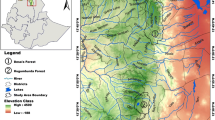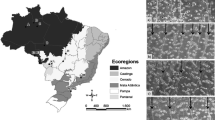Abstract
The knowledge of tree age is important for understanding tree growth and forest dynamics. It may be estimated by ‘direct’ methods involving growth ring counts, or by ‘indirect’ methods involving field measurements of growth rates. Direct methods are considered more accurate, but it is not clear if they are appropriate for all species, notably from the humid tropics. In this paper we assess the occurrence of annual growth rings and their utility for age estimation in three tropical tree species, Acrocarpus fraxinifolius, Dalbergia latifolia (Fabaceae) and Syzygium cumini (Myrtaceae), growing in traditional shade coffee plantations of the southern Western Ghats, India. These species previously were described as having “indistinct or absent” growth rings. We used anatomical studies, field measurements and computational methods to characterise growth rings and assess similarities between directly and indirectly estimated tree ages. Our study revealed that annual growth rings were characterised by different sets of anatomical features per species and were most distinct in the fast-growing deciduous A. fraxinifolius. Growth rates measured in the field showed annual periodicity in all three species, and reflected annual rainfall-drought cycles in D. latifolia and S. cumini. Direct age estimates were most similar to indirect estimates in D. latifolia, and least so in S. cumini. The results of direct age estimation by counting rings are consistent with them being annual in nature in tropical species with distinct and reliable annual growth ring formation. However, for species with poorly defined growth rings, indirect age estimation methods might be more useful.





Similar content being viewed by others
References
Abramoff MD, Magelhaes PJ, Ram SJ (2004) Image processing with image. J Biophotonics Int 11:36–42
Alvim P deT (1964) Tree growth periodicity in tropical climates. In: Zimmerman MH (ed) The formation of wood in forest trees. Academic Press, New York, pp 479–495
Ashton PS (1981) The need for information regarding tree age and growth in tropical forests. In: Bormann FH, Berlyn G (eds) Age and growth rate of tropical trees: new dimensions for research. Yale University, New Haven
Baker PJ (2003) Tree age estimation for the tropics: a test from the southern Appalachians. Ecol Appl 13:1718–1732
Bhattacharyya A, Eckstein D, Shah SK, Chaudhary V (2007) Analyses of climatic changes around Perambikulum, South India, based on early wood mean vessel area of teak. Curr Sci 93:1159–1164
Borchert R (1999) Climatic periodicity, phenology, and cambium activity in tropical dry forest trees. IAWA J 20:239–247
Borgaonkar HP, Sikder AB, Ram S, Pant GB (2010) El Niño and related monsoon drought signals in 523-year-long ring width records of teak (Tectona grandis L.F.) trees from south India. Palaeogeogr Palaeoclimatol Palaeoecol 285:74–84
Boura A, de Franceschi D (2007) Is porous wood structure exclusive of deciduous trees? CR Palevol 6:385–391
Brienen RJW, Zuidema PA (2005) Relating tree growth to rainfall in Bolivian rain forests: a test for six species using tree ring analysis. Oecologia 146:1–12
Brienen RJW, Zuidema PA (2006) Lifetime growth patterns and ages of Bolivian rain forest trees obtained by tree ring analysis. J Ecol 94:481–493
Brienen RJW, Zuidema PA (2007) Incorporating persistent tree growth differences increases estimates of tropical timber yield. Front Ecol Environ 5:302–306
Brienen RJW, Zuidema PA, During HJ (2006) Autocorrelated growth of tropical forest trees: unraveling patterns and quantifying consequences. For Ecol Manage 237:179–190
Chambers JQ, Higuchi N, Schimel JP (1998) Ancient trees in Amazonia. Nature 391:135–136
Cherubini P, Dobbertin M, Innes JL (1998) Potential sampling bias in long-term forest growth trends reconstructed from tree rings: a case study from the Italian Alps. For Ecol Manage 109:103–118
Chowdhury KA (1953) The rôle of initial parenchyma in the transformation of the structure diffuse-porous to ring-porous in the secondary xylem of the genus Gmelina Linn. Proc Nat Inst Sci India 19:361–369
Condit R, Hubbell SP, Foster RB (1995) Mortality rates of 205 Neotropical tree and shrub species and the impact of a severe drought. Ecol Monogr 65:418–439
Détienne P (1989) Appearance and periodicity of growth rings in some tropical woods. IAWA Bull ns 10:123–132
Elliott S, Baker PJ, Borchert R (2006) Leaf flushing during the dry season: the paradox of Asian monsoon forests. Global Ecol Biogeogr 15:248–257
Elouard C (2000) Vegetation features in relation to biogeography. In: Ramakrishnan PS, Chandrashekara UM, Elouard C et al (eds) Mountain biodiversity, land use dynamics, and traditional ecological knowledge. Oxford and IBH, New Delhi, pp 25–42
Estrada GCD, Callado CH, Soares MLG, Lisi CS (2008) Annual growth rings in the mangrove Laguncularia racemosa (Combretaceae). Trees 22:663–670
Fichtler E, Clark DA, Worbes M (2003) Age and long-term growth of trees in an old-growth tropical rain forest, based on analyses of tree rings and 14C. Biotropica 35:306–317
Gamble JS (1922) A manual of Indian timbers (2nd reprint, 2002). International Book Distributors, Dehradun
Gourlay ID (1995) Growth ring characteristics of some African Acacia species. J Trop Ecol 11:121–140
IAWA (1989) IAWA list of microscopic features for hardwood identification. Bull ns 10:221–332
InsideWood (2004-onwards) http://insidewood.lib.ncsu.edu/search. Accessed 9 September 2011
Kukachka BF (1977) Sectioning refractory woods for anatomical studies. USDA Forest Service Research Note, Forest Products Laboratory, Madison
Kumar VVS, Nair KSS, Chacko KC (1993) Phenology and seasonal growth trend of teak at Nilambur (Kerala) India. Ann For 1:42–46
Laurance WF, Nascimento HEM, Laurance SG et al (2004) Inferred longevity of Amazonian rainforest trees based on a long-term demographic study. For Ecol Manage 190:131–143
Lieberman M, Lieberman D (1985) Simulation of growth curves from periodic increment data. Ecology 66:632–635
Lieberman D, Lieberman M, Hartshorn G, Peralta R (1985) Growth rates and age-size relationships of tropical wet forest trees in Costa Rica. J Trop Ecol 1:97–109
Lisi CS, Tomazello FM, Botosso PC et al (2008) Tree-ring formation, radial increment periodicity, and phenology of tree species from a seasonal semi-deciduous forest in southeast Brazil. IAWA J 29:189–207
Martínez-Ramos M, Alvarez-Buylla ER (1998) How old are tropical forest trees? Trends Pl Sci 3:400–405
Metcalf CJE, Horvitz CC, Tuljapurkar S, Clark DA (2009) A time to grow and a time to die: a new way to analyze the dynamics of size, light, age, and death of tropical trees. Ecology 90:2766–2778
Nath CD, Dattaraja HS, Suresh HS et al (2006) Patterns of tree growth in relation to environmental variability in the tropical dry deciduous forest at Mudumalai, southern India. J Biosci 31:651–669
Nath CD, Pélissier R, Ramesh BR, Garcia C (2011) Promoting native trees in shade coffee plantations of southern India: Comparison of growth rates with the exotic Grevillea robusta. Agrofor Syst 83:107–119
Ogden J (1981) Dendrochronological studies and the determination of tree ages in the Australian tropics. J Biogeogr 8:405–420
Pearson RS, Brown HP (1932) Commercial timbers of India. Govt. of India Central Publication Branch, Calcutta
Pélissier R, Pascal J-P (2000) Two-year tree growth patterns investigated from monthly girth records using dendrometer bands in a wet evergreen forest in India. J Trop Ecol 16:429–446
Poussart P, Evans M, Schrag D (2004) Resolving seasonality in tropical trees: multi-decade, high-resolution oxygen and carbon isotope records from Indonesia and Thailand. Earth Planet Sci Lett 218:301–316
Priya PB, Bhat KM (1998) False ring formation in teak (Tectona grandis L.f.) and the influence of environmental factors. For Ecol Manage 108:215–222
Priya PB, Bhat KM (1999) Influence of rainfall, irrigation and age on the growth periodicity and wood structure in teak (Tectona grandis). IAWA J 20:181–192
Purkayastha SK (1997) A manual of Indian timbers. Sribhumi Publishing Co, Calcutta
Rao KR, Purkayastha SK (1972) Indian woods: their identification, properties and uses. FRI Press, Dehradun
Rozendaal DMA, Zuidema PA (2011) Dendroecology in the tropics: a review. Trees 25:3–16
Rozendaal DMA, Brienen RJW, Soliz-Gamboa CC, Zuidema PA (2010) Tropical tree rings reveal preferential survival of fast growing juveniles and increased juvenile growth rates over time. New Phytol 185:759–769
Sánchez-González M, Tomé M, Montero G (2005) Modeling height and diameter growth of dominant cork oak trees in Spain. Ann For Sci 62:633–643
Schöngart J (2008) Growth-Oriented Logging (GOL): a new concept towards sustainable forest management in Central Amazonian várzea floodplains. For Ecol Manage 256:46–58
Schöngart J, Piedade MTF, Ludwigshausen S et al (2002) Phenology and stem-growth periodicity of tree species in Amazonian floodplain forests. J Trop Ecol 18:581–597
Schöngart J, Piedade MTF, Wittmann F et al (2005) Wood growth patterns of Macrolobium acaciifolium (Benth.) Benth. (Fabaceae) in Amazonian black-water and white-water floodplain forests. Oecologia 145:454–461
Stahle DW (1999) Useful strategies for the development of tropical tree ring chronologies. IAWA J 20:249–253
Terborgh J, Flores CN, Mueller P, Davenport L (1997) Estimating the ages of successional stands of tropical trees from growth increments. J Trop Ecol 14:833–885
Vetter R, Botosso P (1989) Remarks on age and growth rate determination of Amazonian trees. IAWA Bull (NS). 10:133–145
Worbes M (1995) How to measure growth dynamics in tropical trees: a review. IAWA J 16:337–351
Worbes M (1999) Annual growth rings, rainfall-dependent growth and long-term growth patterns of tropical trees from the Caparo Forest Reserve in Venezuela. J Ecol 87:391–403
Worbes M (2002) One hundred years of tree-ring research in the tropics—a brief history and an outlook to future challenges. Dendrochronologia 20:217–231
Worbes M, Junk WJ (1999) How old are tropical trees? The persistence of a myth. IAWA J 20:255–260
Zuidema PA, Vlam M, Chien PD (2011) Ages and long-term growth patterns of four threatened Vietnamese tree species. Trees 25:29–38
Acknowledgments
The study was funded by a Critical Ecosystems Partnership Fund Small Grant (CEPF-WG, administered by Ashoka Trust for Research in Ecology and Environment, India). Additional funds were provided by INRA (Institut National de la Recherche Agronomique), France; French Institute of Pondicherry, India; and CAFNET project (Connecting, enhancing and sustaining environmental services and market values of coffee agroforestry in Central America, East Africa and India, CAFNET-Europaid/ENV/2006/114-382/TPS). We thank Tata Coffee Ltd., BBTC Ltd. (Elkhill Group), Biodiversity Conservation India Ltd., and Kabinakad Estate, and several individual farmers who provided permissions and valuable research support. We thank S. Ramalingam for preparing dendrometer bands, S. Aravajy and N. Barathan for tree identifications, Nicole Salel for preparing microscope slides, G. Jayapalan for compiling climate data, and J.D. Murugesh and A. Prathap for field assistance. We also thank Christine Heinz and Pierre Détienne for discussions on growth ring identification, and Paulo Botosso and three reviewers for helpful suggestions on the manuscript.
Author information
Authors and Affiliations
Corresponding author
Additional information
Communicated by S. Leavitt.
Rights and permissions
About this article
Cite this article
Nath, C.D., Boura, A., De Franceschi, D. et al. Assessing the utility of direct and indirect methods for estimating tropical tree age in the Western Ghats, India. Trees 26, 1017–1029 (2012). https://doi.org/10.1007/s00468-012-0679-6
Received:
Revised:
Accepted:
Published:
Issue Date:
DOI: https://doi.org/10.1007/s00468-012-0679-6




